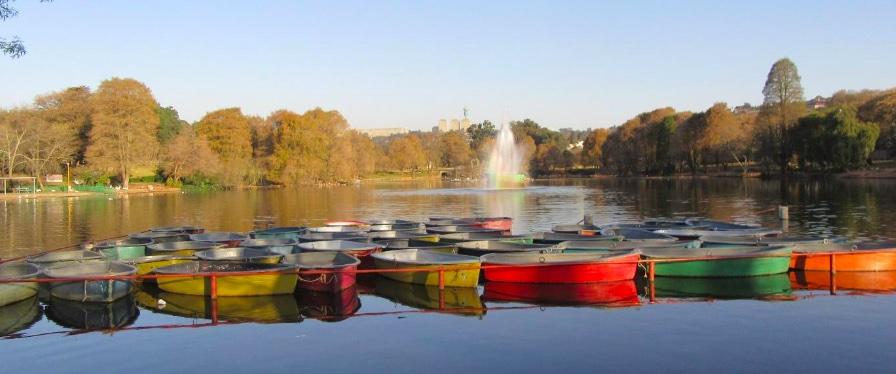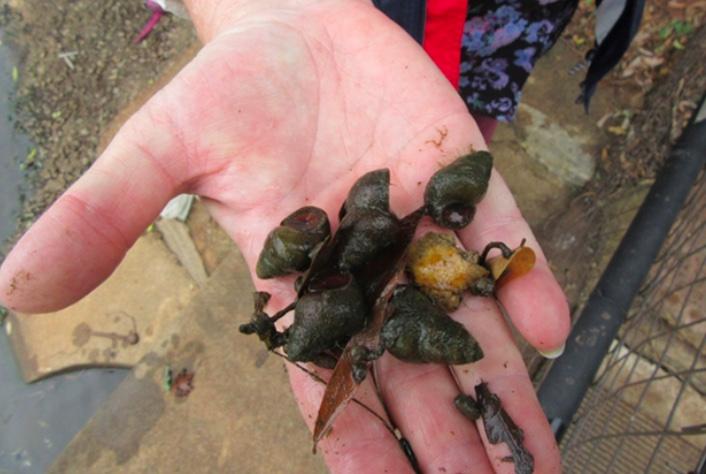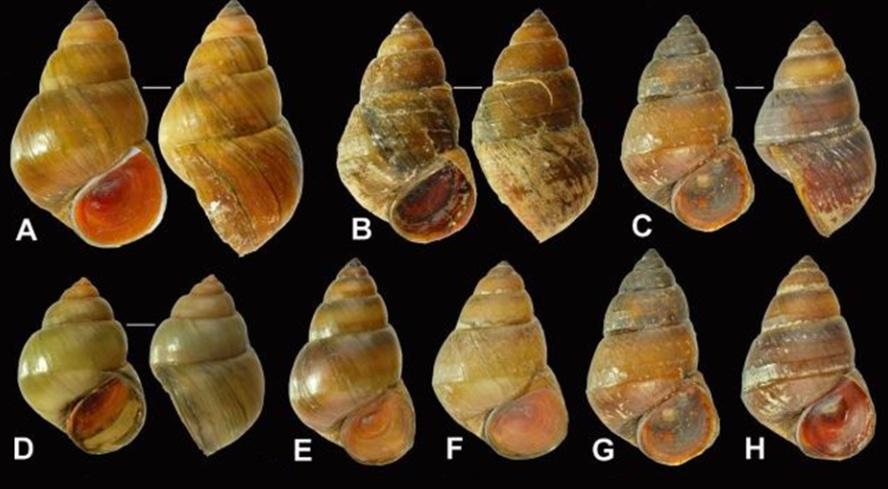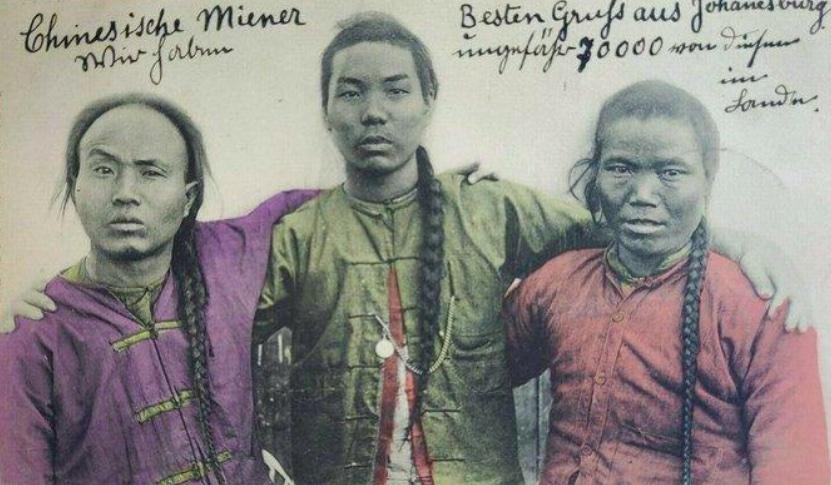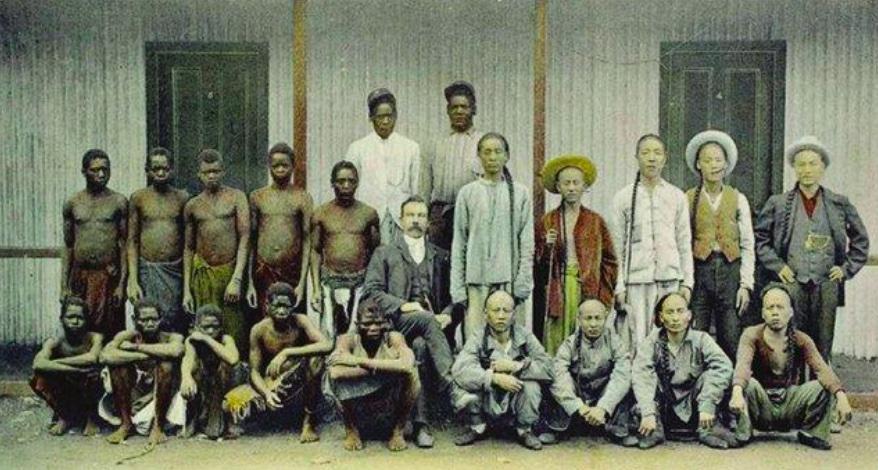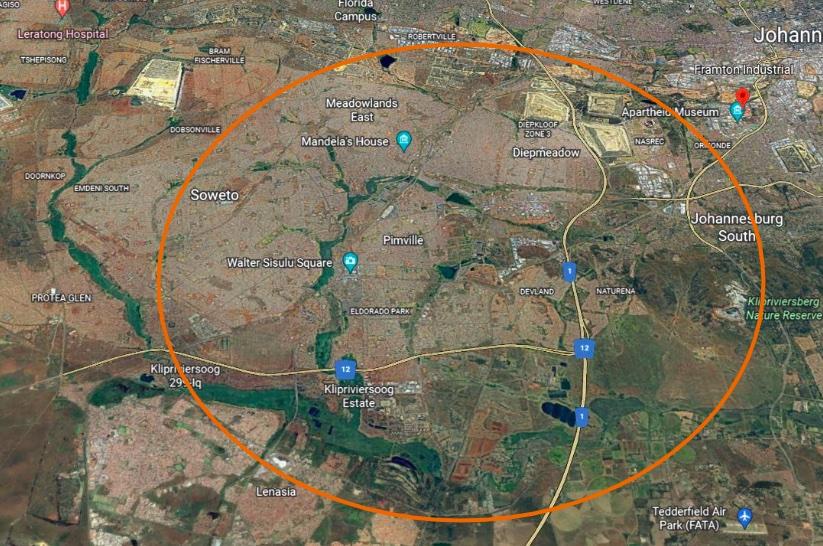Disclaimer: Any views expressed by individuals and organisations are their own and do not in any way represent the views of The Heritage Portal. If you find any mistakes or historical inaccuracies, please contact the editor.
This article explores the presence of an Asian freshwater food snail species discovered in Zoo Lake in Johannesburg in 2019. These non-indigenous snails could be a fascinating, living legacy of anonymous Chinese indentured labourers brought to work on the Witwatersrand gold fields in the early 1900s.
In 1904, 64 000 Chinese indentured workers were brought to Johannesburg to work on the newly established gold mines to overcome a shortage of mine labour. Other than a few photographs, the identity of these individuals is long since lost, but perhaps not entirely forgotten. It is possible that these migrants brought the freshwater snails with them as food items for informal aquaculture, and that these snails quietly live on in and around the old Witwatersrand goldfields.
Zoo Lake is an urban impoundment fed by the Parktown Spruit from a nearby Westcliff ridge and by the storm water drains of the catchment. The water is habitually heavily polluted and experiences seasonal algal blooms.
A peaceful scene at Zoo Lake, Johannesburg, 2019 (Sue Taylor)
An unusual water snail is discovered
In 2019, I noticed a single large water snail on the northern weir and took a photograph. The photograph was sent to Dr Chris Appleton, a retired mollusc specialist in South Africa, and he passed the image on to Dr Nelson Miranda, another specialist. Discussions ensued, samples were collected and DNA analysis carried out, resulting in a formal identification. The snail was Sinotaia cf. quadrata (Benson, 1842) (Miranda et al., 2022). The ‘cf’ means that it looks like the species called ‘quadrata’, but might be slightly different. The ‘Benson 1842’ relates to the first person to identify and name this species and the date. The snail has been known for a long time, and it may be creeping its way slowly around the world, helped by human migration.
The large Asian freshwater snail, Sinotaia cf. quadrata (Benson, 1842) discovered at Zoo Lake, Johannesburg in 2019. The snails reach considerable densities in the water, a characteristic which would favour their use as a food species. (Sue Taylor)
A bit of a puzzle
It is not known when or how Sinotaia quadrata found its way into Zoo Lake and determining this would require detailed field sampling and historical research. It is possible that they are in other water bodies of the Witwatersrand, but no-one has looked. In trying to explain this introduction, It could be proposed that the almost 64 000 Chinese men who were brought to the Witwatersrand as indentured labour in 1904 brought live food snails with them.
The consumption of freshwater snails is very common in Asian countries, as well as in the Mediterranean and Africa. These labourers had been recruited from the Chinese provinces of Zhili, Shandong and Henan and are said to have been rural people. It is possible that these men may have had a cultural practice of using harvested or ‘farmed’ snails as a supplement to their diet, and then brought these snails with them to South Africa as part of their food security strategy. The Zoo Lake snails are closely related to the “Chinese Mystery Snail’ (Cipangopalludina chinensis) which is edible and also highly invasive in new habitats.
Other Sinotaia quadrata discoveries round the world
This species is definitely on the move globally, but its mechanism of travel around the world is not fully understood. Sinotaia quadrata has recently been reported in Central Italy (Tuscany) and has never been collected in any European country before 2017 (Cianfanelli et al, 2017). In their paper, Cianfanelli et al. (2017) speculate that the cultural traditions and traditional cuisine could act as a main driver of the introduction and spread of this species in Italy and other European countries.
Cleaned shells of Sinotaia cf. quadrata showing their variable shape, size and colour. These specimens are from Italy. (Cianfanelli et al., 2017)
In Argentina where Sinotaia cf quadrata has also been found, the snail was found in a wide variety of habitats and water qualities, including moderately polluted water (Ferreira et al. 2017). These authors did not have much to say about how Sinotaia got into their streams. A paper by Ng et al. (2014) suggested that other non-native species of Sinotaia were accidentally introduced into Singapore from China along with ornamental carp, carp being widely used in ornamental ponds and also as a fishing species.
Looking for evidence of a ‘ground zero’ for the Witwatersrand’s Sinotaia snails
Because these snails are known as Asian food snails, and because 64 000 Chinese indentured workers were brought to the Witwatersrand in 1904, one hypothesis is that these workers brought the snails with them, but there is no evidence of this at present. The original Chinese migrants may have tried to cultivate the snails in local freshwater bodies and some of the snails escaped, or the labourers threw some of them away when they didn't want them anymore. These snails are very resilient and because of their operculum, a leathery trapdoor, they can survive in very unfavourable conditions.
The Chinese men who were recruited by the British government and imported on contract to the Johannesburg gold fields were unskilled labourers and experienced arduous working conditions when they got to the Witwatersrand gold fields (Meyer and Steyn, 2016). They probably did not know what they were signing up for when they left China. By 1911 the scheme of bringing in Chinese labourers was abandoned by the British government in South Africa and all the Chinese labourers repatriated. That is, other than those that died in South Africa, including those found buried in unmarked graves under a Crown Mines mine dump in 2010 (see more below).
Young Chinese men in South Africa, 1905. The first Chinese labourers arrived at Witwatersrand on June 19th 1904.
“On the Rand. White, Black and Yellow.'' Coloured Print. Braune and Levy, Johannesburg. No. 425. (Museum Africa, South Africa). Featured in a paper by Tu Huynh, 2008.
Searching for the snail
Research is needed to consolidate information on the places where the Chinese migrants would have lived and worked. Water bodies downstream of areas where the 1904 Chinese migrants lived or were housed during the early days of Johannesburg would be good places to look for established populations of the introduced snails. The Chinese labourers were also employed on the East Rand gold fields and streams and wetlands in this very broad area could also be searched for examples of Sinotaia cf quadrata.
Because introduced species can take a long time to adapt to conditions in their new locality, they may remain hidden or in small numbers for decades before they begin to emerge as new populations of these species. At Zoo Lake, there are literally thousands of these snails, which may mean that they were introduced long ago and have had time to adapt. At some point, perhaps very recently, their populations began to do well and were noticed for the first time. However, it is a bit odd that the stream (Parktown Spruit) and storm water drains feeding Zoo Lake are nowhere near any place where the Chinese indentured labourers lived or worked. And moreover, Zoo Lake is on the wrong side (north) of the Witwatersrand watershed. Almost all of the early Johannesburg gold mines are on the south side of the watershed, which means that streams local to these mines flow south and none flow into Zoo Lake.
Starting with a long forgotten burial site
Some details could be gleaned from the locality of the very large Crown Mines slimes dam which has recently been removed for reprocessing. During the removal process, an unmarked cemetery was discovered near Frampton Industrial Park. The cemetery was found to have been used between 1890 and 1920 before it was covered by mine tailings and forgotten (Lander 2015). Recent forensic and archaeological research found 650 graves, and from these, 100 sets of human remains were exhumed for investigation. Some of the graves contained the remains of unknown Chinese persons who were likely to have been part of the 64 000 hired as indentured labourers. They were identified by their hair and skeletal features (Lander, 2015). Most of the other remains were of black mine workers. Death was likely to have been caused by diseases like TB and mining accidents which were common during that time.
Crown Mines could be used as the centre point to pinpoint streams, wetlands and water bodies south of the Witwatersrand watershed, but this is a huge area to be sampled for any sign of the snail.
The vast area south of the Crown Mines locality showing the many streams and wetlands, indicating how challenging it would be to find this snail in freshwater habitats south of any localities where indentured Chinese workers may have lived. (Google Earth, 2015).
What next?
So, if not brought into South Africa by Chinese migrants, how did these non-native snails get to the Witwatersrand and into Zoo Lake? The pathway of many non-native species to a new locality is often from accidental introductions via the aquatic pet trade, where eggs of foreign species may be attached to imported freshwater fish and plants, or even to animals. Upstream of the Zoo Lake is the Johannesburg Zoo, but discussions with staff reveal that these snails have not been noticed at the Zoo (although perhaps it is time for another look), nor have aquatic plants and animals ever been imported directly from Asia.
Early warnings signs of a biological invasion
It is possible that the population of Sinotaia cf quadrata is about to go ‘supernova’ on the Witwatersrand because of climate change and warming conditions. The snails are very tolerant to heat and do well in shallow, slow flowing waters, as well as moderately polluted streams – which is about all of the small streams in South Africa! There are already thousands of these snails at Zoo Lake. They do not seem to do harm as they are not a biofouling species (clogging up every hard surface) and do not devastate macro-vegetation (reeds, water lilies, bulrushes), but rather quietly scrape algae off underwater rocks.
Because of the way that camouflaging algae grows on their shells (see below), they are difficult to see and go unnoticed by many visitors to the Lake.
Sinotaia quadrata at Zoo Lake amongst the algae they consume. 2019. The snails are about 2.5 cm long and well camouflaged. (Sue Taylor)
About the author: Sue Taylor holds a PhD in Plant Biotechnology from the University of KwaZulu-Natal, South Africa. She is a development consultant with experience in researching, writing and lecturing about climate change and social/development issues in South Africa and Africa. She has worked in the biotechnology research sector, in nature conservation and in the NGO sector as a climate change activist, and more recently as a science writer. Her current interest is cities, urban climate change adaptation and bicultural heritage. She takes her citizen science role very seriously and is always looking for interesting things to write about.
References
- Cianfanelli S., Stasolla G., Inghilesi AF., Tricarico E.l, Goti E., Strangii A., Bodon M (2017). First European record of Sinotaia quadrata (Benson, 1842), an alien invasive freshwater species: accidental or voluntary introduction? (Caenogastropoda: Viviparidae). Bollettino Malacologigo 53(2): 150-160 (2017).
- Ferreira A et al. (2017). Ecology of the non-native snail Sinotaia cf quadrata (Caenogastropoda: Viviparidae). A study in a lowland stream of South America with different water qualities. Annals of the Brazilian Academy of Sciences 89(2): 1059 – 1072.
- Lander S (2015). Unmarked Historical Cemetery in the Crown Mines Area. The Digging Stick, 32(1), April 2015.
- Liew JH et al. (2020). Tropical Freshwater Ecosystems, Biota and Anthropogenic Activity with reference to South-East Asia. Chapter Two, in Climate change and infectious Fish Diseases.
- Meyer A and Steyn M (2015). Chinese indentured mine labour and the dangers associated with early 20th Century deep-level mining on the Witwatersrand gold mines. International Journal of Osteoarcheaeology , 26(4): 648-660.
- Miranda NAF, Taylor SJ, Cwewe Y and Appleton CC (2022). First record of the Asian freshwater snail Sinotaia cf. quadrata (Benson, 1842) from Africa. BioInvasions Records (2022) Volume 11.
- Ng et al. (2014) The Taxonomy, Distribution and Introduction History of the Earliest Reported Alien Freshwater Mollusc in Singapore — Sinotaia guangdungensis (Gastropoda: Viviparidae).
Comments will load below. If for any reason none appear click here for some troubleshooting tips. If you would like to post a comment and need instructions click here.

